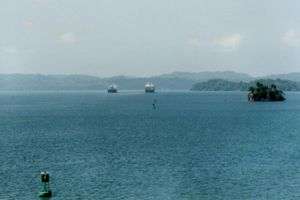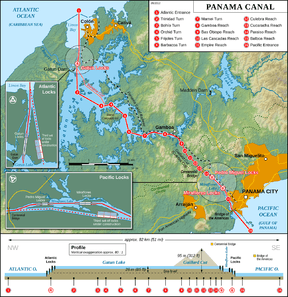Gatun Lake
| Gatun Lake | |
|---|---|
 Ships follow marked channels among the hilltop islands | |
| Coordinates | 9°11′N 79°53′W / 9.183°N 79.883°WCoordinates: 9°11′N 79°53′W / 9.183°N 79.883°W |
| Type | artificial lake |
| Primary inflows | Chagres River |
| Basin countries | Panama |
| Surface area | 425 km² |
| Surface elevation | 26 m |
| Islands | Isla Barro Colorado, Isla Gatun, Isla Falta Calzado, Isla Tres Perros |
Gatun Lake (Sp. Lago Gatún) is a large artificial lake to the south of Colón, Panama. It forms a major part of the Panama Canal, carrying ships for 33 km (21 mi) of their transit across the Isthmus of Panama.
The lake was created between 1907 and 1913 by the building of the Gatun Dam across the Chagres River. At the time it was created, Gatun Lake was the largest man-made lake in the world. Gatun Dam was also the largest of its kind.
Description
The lake is situated in the valley of the Chagres River. It was formed, and the river widened and deepened, by the construction of the Gatun Dam about 10 km (6.2 mi) from the river's mouth in the Caribbean Sea in 1907–1913. The geography of the area was ideal for the creation of a large lake here; the hills bordering the valley of the Chagres open up widely around the area of the lake, but come together to form a gap just over 2 km (1.2 mi) wide at the location of the dam. The damming of the river flooded the originally wooded valley; almost a century later, the stumps of old mahogany trees can still be seen rising from the water, and submerged snags form a hazard for any small vessels that wander off the marked channels.
Gatun Lake has an area of 425 km2 (164 sq mi) at its normal level of 26 m (85 ft) above sea level; it stores 5.2 cubic kilometres (183,000,000,000 ft³) of water, which is about as much as the Chagres River brings down in an average year.
With the creation of the lake many hilltops became islands. The biggest and best known of them is Barro Colorado Island, home of the world-famous Smithsonian Tropical Research Institute (STRI).
The lake has given its name to the Gatun structure, which may be an eroded impact crater.
Role in the canal

Gatun Lake forms a major component of the Panama Canal; the lake, including the flooded arm extending up the Chagres River, makes up 32.7 km (20.3 mi) of the raised part of the waterway, the other part being the 12.6 km (7.83 mi) Culebra Cut.
The canal follows a clearly marked route around the lake's islands, following the deeper water south from Gatun Locks, and then east. A small "shortcut" channel, the "Banana Cut", runs between the islands, providing a slightly shorter route through the lake; this is used by canal launches and yachts to cut a little time off the crossing, and to avoid the heavy ship traffic.
The lake is also important as a reservoir of water for the operation of the canal locks. Each time a ship transits the canal 202,000 m3 (53,400,000 US gal) of water is passed from the lake into the sea; with over 14,000 vessel transits per year, this represents a very large demand for water. Since rainfall is seasonal in Panama, the lake acts as a water store, allowing the canal to continue operation through the dry season.
A major factor in water regulation is the ability of the rainforest in the lake's watershed to absorb rainfall, releasing it gradually into the lake. However, significant deforestation of the watershed has cleared away much of the vegetation, and reduced the area's water capacity. This has resulted in falling water levels in the lake during the dry season. Coupled with the massive increase in canal traffic since its opening, and the resultant increase in water usage, this is an ongoing problem for the canal (see Panama Canal: Water issues).
Gatun Lake supplementary benefits
Created in 1913 by the damming of the Chagres River, Gatun Lake is an essential part of the Panama Canal which forms a water passage between the Atlantic Ocean and the Pacific Ocean, permitting ship transit in both directions. At the time it was formed, Gatun Lake was the largest man-made lake in the world. The impassable rain-forest around Gatun Lake has been the best defense of the Panama Canal. Today these areas have endured practically unscathed by human interference and are one of the few accessible areas on Earth where various native Central American animal and plant species can be observed undisturbed in their natural habitat.
Barro Colorado Island, which was established for scientific study when the lake was formed and is today operated by the Smithsonian Institution, is the largest island on Gatun Lake. Many of the most important ground breaking scientific and biological discoveries of the tropical animal and plant kingdom originated here. Lake Gatun encompasses approximately 180 square miles (470 km2), a tropical ecological zone part of the Atlantic Forest Corridor and ecotourism on Gatun Lake has become a worthwhile industry for Panamanians. Gatun Lake also serves to provide the millions of gallons of water necessary to operate the Panama Canal locks each time a ship passes through and provides drinking water for Panama City and Colon.
Angling is one of the primary recreational pursuits on Gatun Lake. Non-native Peacock Bass were introduced by accident to Gatun Lake around 1967[1] by a local businessman,[2] and have since flourished to become the dominant angling game fish in Gatun Lake. Locally called Sargento, and believed to be the species Cichla Pleiozona,[3] these peacock bass are not a native game fish of Panama but originate from the Amazon, Rio Negro and Orinoco river basins of South America where they are called Tucanare or Pavon and are considered a premier game fish.
Notes
- ↑ Zaret, Thomas M.; Paine, R.T. (2 November 1973). "Species Introduction in a Tropical Lake". Science. 182 (4111): 449–455. doi:10.1126/science.182.4111.449. PMID 17832455.
- ↑ "Peacock Bass: Fun to Catch, Fine to Eat". Panama Canal Review. February 1971: 11. Retrieved 2012-04-30.
- ↑ "Gatun Lake Peacock Bass Fishing Charters". Retrieved 2012-04-30.
References
- History Of The Panama Canal, by Ira E. Bennett
- The Panama Canal, by Colonel George W. Goethals